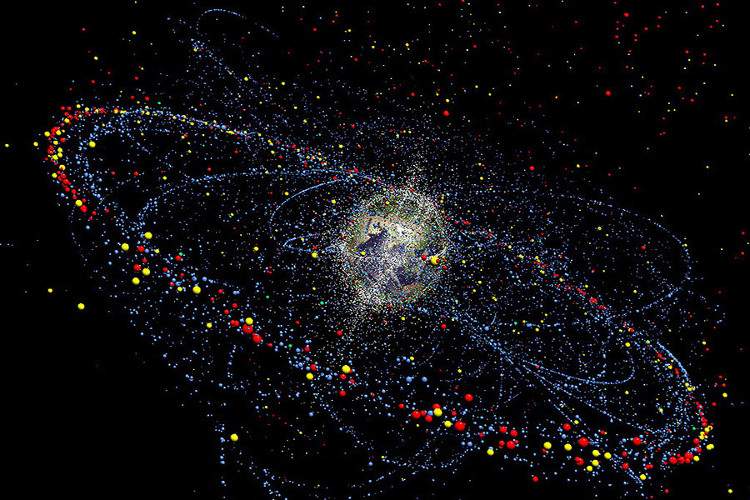Cosmic garbage!
About more than 9,000 pieces of cosmic trash from satellite materials, insulating pieces on the hull, debris of the fuel cell . are floating in orbit around the Earth. This amount of cosmic waste is constantly increasing, currently predicting the total weight of cosmic garbage has reached more than 5,500 tons.
They include missile bodies, used satellites . This is also the main source of pollution of the space environment.
Space garbage is constantly increasing
Space waste (RVT) is a fragment or residual object of human aerospace activity that flies in space.
RVT is like an artificial satellite flying around the earth in a certain orbit, forming a "garbage belt".
In a recent report by the US National Aviation Administration scientists, the issue of travel or work in the universe will be more and more dangerous by cosmic garbage. The problem is that now, people still do not have effective measures to collect and solve this kind of waste.

Cosmic trash surrounds the Earth and causes concern for the scientific community.
A forecast by the Johnson Aeronautics Center (USA) said that if countries do not launch more satellites and missiles, the RVT numbers will be stable from now until 2055. But this number will increase, within the next 2 centuries. The number of RVTs will increase from the current number of 9,000 pieces to 11,000 pieces, as the pieces of trash will collide with each other and divide into smaller pieces.
The US space monitoring network is currently tracking pieces of 10cm in diameter, of which 17% are rocket propellers, 31% are waste satellites, 38% are fragments of collisions, In addition, 13% is garbage of other types of space equipment, totaling up to 5500 tons.
In addition, there are thousands of other debris pieces. Most of the debris comes from satellite explosions, the orbital fuel chamber is often crumbled due to high pressure.
RVT numbers mostly come from Russia and the US.
Since 1991, scientists have recorded three collisions between RVT with a diameter of over 10cm. The last time in January 2005, an American waste satellite that flew in the 31-year-old space crashed some of the broken parts of the HKVT device, but all three collisions did not form debris. less.
Death debris in the universe
Researchers predict that there will be 18 collisions in the next 200 years, but the number of collisions is not much, but for expensive satellites and manned spacecraft the consequences are likely to be destruction. kill.
The flying speed of debris can reach 2.2 thousand miles / hour, this speed can cause debris to penetrate spacecraft or satellites, causing power failure .
Among those RVTs, the greatest danger comes from metal scrap, their flight speed can reach 1.6 km / sec. With such a movement speed, a metal particle with a diameter of 0.5mm can also penetrate astronauts' suits.
The 2003 explosion of the Colombian ship was predicted by NASA because the ship had been struck by a small meteorite or cosmic garbage.
The most concentrated RVT density is from 550 to 635 miles from the ground. Because manned spacecraft do not reach this height, so the level of danger is not much, but the satellites for commercial or scientific purposes still exist this danger.
Only when "cleaning" large objects in orbit will avoid potential risks to the HKVT industry. But now, both in economic and technical terms, there is no way to solve the problem.
Grid to prevent . cosmic garbage

Clean up trash with a net.
To avoid RVT's collision with space equipment, researchers from Russia's National Aerospace Systems Research Institute (HKVT) and Applied Research Institute after years of research and experimentation has succeeded in developing a collision-proof screen mesh tank between HKVT device and RVT.
This screen has an important feature of being scanned with a special layer of material, when there is a collision, the energy generated by the collision causes the screen and RVT to generate a chemical reaction in the direction Explode, make debris into powder. This mesh screen can also make the RVT pieces collide on the horizontal surface to increase the contact area, reduce the impact intensity.
A method proposed by scientists to prevent an increase in the number of RVTs is to add satellites or parts that drive a journey so that they return to Earth, but this idea will increase the cost, The engine parts and control system will be even more complicated. In addition, there is another idea of launching a laser from the ground to alter the flight trajectory of the debris, but this is also a difficult idea to implement because of the large amount of RVT and need to use a certain amount Large amounts for laser.
Tuyet Nhung
- Europe studies the project of clearing cosmic garbage
- Turn garbage in the universe into radiation shield
- The danger when cosmic garbage returns to devastate the Earth
- Effective way to deal with cosmic garbage
- Russia developed a system to eliminate cosmic garbage
- America - Japan cooperates to monitor pillar garbage
- Which country discharges the most waste into the universe?
- 'Overload' cosmic garbage
- Clear up garbage on the vast universe
- US-Australia cooperates to fight cosmic garbage
- The risk of meteorites and cosmic waste threatens the Earth
- Alarm on garbage on the universe
 Van Allen's belt and evidence that the Apollo 11 mission to the Moon was myth
Van Allen's belt and evidence that the Apollo 11 mission to the Moon was myth The levels of civilization in the universe (Kardashev scale)
The levels of civilization in the universe (Kardashev scale) Today Mars, the sun and the Earth are aligned
Today Mars, the sun and the Earth are aligned The Amazon owner announced a secret plan to build a space base for thousands of people
The Amazon owner announced a secret plan to build a space base for thousands of people